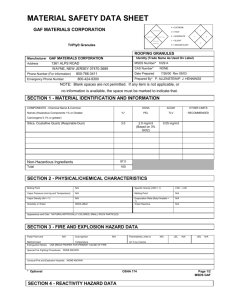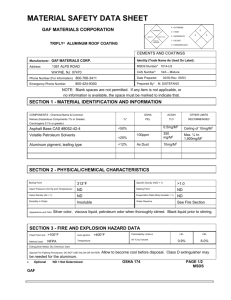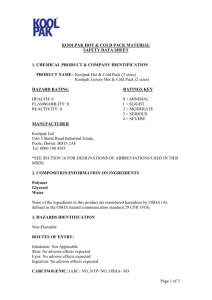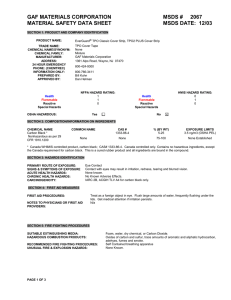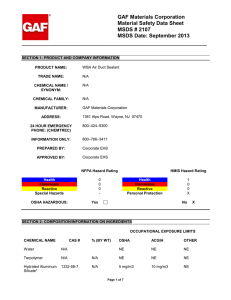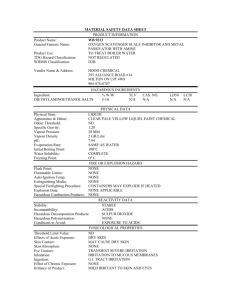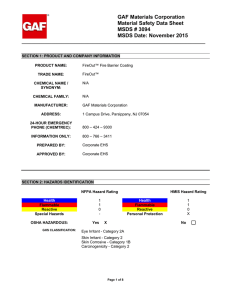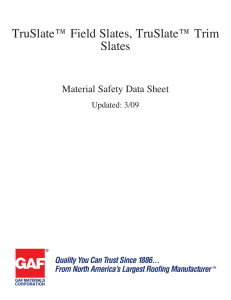EverGuard® Caulking Material Safety Data Sheet Updated: 12/08
advertisement
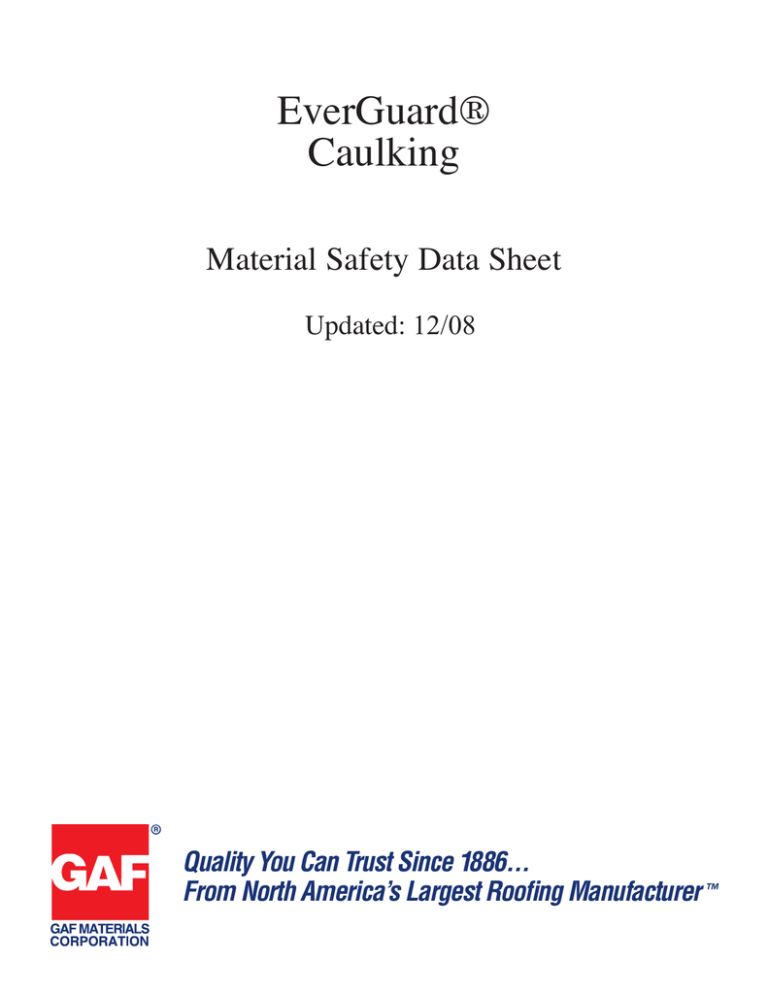
EverGuard® Caulking Material Safety Data Sheet Updated: 12/08 Quality You Can Trust Since 1886... From North America’s Largest Roofing Manufactur Quality You Can Trust Since 1886... From North America’s Largest Roofing Manufacturer ™ GAF Materials Corporation Material Safety Data Sheet MSDS # 2015 MSDS Date: December 2008 _________________________________________________________________________ SECTION 1: PRODUCT AND COMPANY INFORMATION GAF 7631M Everguard® Caulking PRODUCT NAME: Everguard® Caulking TRADE NAME: CHEMICAL NAME / SYNONYM: N/A CHEMICAL FAMILY: N/A GAF Materials Corporation MANUFACTURER: 1361 Alps Road, Wayne, NJ 07470 ADDRESS: 24-HOUR EMERGENCY PHONE (CHEMTREC): 800 – 424 – 9300 INFORMATION ONLY: 800 – 766 – 3411 PREPARED BY: Corporate EHS APPROVED BY: Corporate EHS NFPA Hazard Rating HMIS Hazard Rating 1 3 0 - Health Flammable Reactive Special Hazards OSHA HAZARDOUS: Yes 1 3 0 X Health Flammable Reactive Personal Protection X No SECTION 2: COMPOSITION/INFORMATION ON INGREDIENTS OCCUPATIONAL EXPOSURE LIMITS CHEMICAL NAME CAS # % (BY WT) OSHA ACGIH OTHER Petroleum HydroCarbon Mixture 8032-32-4 N/A NE 300ppm REL: 350 mg/m3 Titanium Dioxide 13463-67-7 N/A 15 mg/m3 – total 10 mg/m3 – total REL: lowest feasible concentration Page 1 of 7 GAF Materials Corporation MSDS # 2015 OCCUPATIONAL EXPOSURE LIMITS CHEMICAL NAME CAS # % (BY WT) OSHA ACGIH OTHER Talc 14807-96-6 N/A 20 mppcf (containing <1% Quartz) 2 mg/m3 REL: 2 mg/m3 – resp. Crystalline Silica 14808-60-7 N/A 10 mg/m3 / (% SiO2 + 2) – resp. 0.025 mg/m3 REL: 0.05 mg/m3 – resp. NE = Not Established SECTION 3: HAZARDS IDENTIFICATION PRIMARY ROUTE OF EXPOSURE: Skin, eyes and inhalation. SIGNS & SYMPTOMS OF EXPOSURE EYES: May cause eye irritation. SKIN: May cause defatting and irritation of the skin. INGESTION: Can cause gastrointestinal irritation, nausea, and vomiting. Aspiration of material into lung may cause chemical pneumonitis which can be fatal. INHALATION: May cause nose or throat irritation. High concentrations may cause acute central nervous system depression characterized by headaches, dizziness, nausea and confusion. ACUTE HEALTH HAZARDS: See above. CHRONIC HEALTH HAZARDS: Repeated and prolonged occupational overexposure to crystalline silica may cause silicosis, a progressively disabling lung disease. Preexisting respiratory conditions may be aggravated by exposure to crystalline silica. CARCINOGENICITY: Titanium dioxide IS NOT listed as a potential carcinogen by the National Toxicology Program, the International Agency for Research on Cancer, OSHA, or A.C.G.I.H. The International Agency for Research on Cancer considers crystalline silica to have limited evidence of carcinogenicity in humans and sufficient evidence in experimental animals (IARC Group 2A). SECTION 4: FIRST AID MEASURES Page 2 of 7 GAF Materials Corporation MSDS # 2015 FIRST AID PROCEDURES EYES: Flush with large amounts of water, lifting upper and lower lids occasionally. Continue for at least 15 minutes. Get medical attention immediately. SKIN: Remove contaminated clothing. Wash affected area with soap and water. Obtain medical attention if irritation persists. INHALATION: Remove to fresh air immediately. If breathing has stopped, give artificial respiration. Keep warm and quiet. Get medical attention immediately. INGESTION: If swallowed do not induce vomiting. (Never give anything by mouth to an unconscious person). Call Poison Control Center, Hospital Emergency Room, or Physician immediately. NOTES TO PHYSICIANS OR FIRST AID PROVIDERS: Any treatment that might be required for overexposure should be directed at the control of symptoms and the clinical conditions. SECTION 5: FIRE FIGHTING PROCEDURES SUITABLE EXTINGUISHING MEDIA: FLAMMABLE LIQUID - CLASS IC Use NFPA Class B Fire extinguishers (carbon dioxide, all purpose dry chemical or alcohol foam) designed to extinguish flammable liquid fires. Polymer foam is preferred for large fires. HAZARDOUS COMBUSTION PRODUCTS: During emergency conditions, overexposure to decomposition products may cause a health hazard. Symptoms may not be immediately apparent. Obtain medical attention. WARNING! FLAMMABLE. RECOMMENDED FIRE FIGHTING PROCEDURES: SCBA and bunker gear. UNUSUAL FIRE & EXPLOSION HAZARDS: Water may be ineffective, but may be used to cool exposed containers to prevent pressure build-up and possible autoignition or explosion when exposed to extreme heat. If water is used, fog nozzles are preferable. SECTION 6: ACCIDENTAL RELEASE MEASURES ACCIDENTAL RELEASE MEASURES: Refer to Section 8 and don respirators, eye, hand, and body protection appropriate for the size of the spill and the exposures encountered. Keep spectators away. Eliminate all ignition sources (flames, hot surfaces, and sources of electrical, static or frictional sparks). Dike and contain spill with inert material (e.g. sand, Page 3 of 7 GAF Materials Corporation MSDS # 2015 earth). Transfer liquids to covered metal containers for recovery or disposal, or remove with inert absorbent. Use only non-sparking tools. Place absorbent diking materials in covered metal containers for disposal. Prevent contamination of sewers, streams, and groundwater with spilled material or used absorbent. RCRA D001. SECTION 7: HANDLING AND STORAGE HANDLING AND STORAGE: OTHER PRECAUTIONS: Do not store above 115 °F (46 °C) store large quantities in compliance with OSHA 29CFR1910.106. Do not take internally. Close container after each use. Avoid skin contact. Do not breathe sanding dust. Empty containers must not be washed and re-used for any purpose. Containers should be grounded and bonded to the receiving container. Do not weld, braze or cut on empty container. Never use pressure to empty. Drum is not a pressure vessel. SECTION 8: EXPOSURE CONTROLS/PERSONAL PROTECTION ENGINEERING CONTROLS / VENTILATION: Use appropriate general and or local ventilation. RESPIRATORY PROTECTION: Proper selection of respiratory protection depends upon many factors including duration/level of exposure and conditions of use. In general exposure to organic chemicals such as those contained in this product may not require the use of respiratory protection if used in well ventilated areas. In restricted ventilation areas a NIOSH approved chemical cartridge respirator may be required. Under certain conditions, such as spraying, a mechanical prefilter may also be required. In confined areas use a NIOSH/ MSHA approved air supplied respirator. If the TLV's listed in Section II are exceeded use a properly fitted NIOSH/MSHA approved respirator with an appropriate protection factor. Refer to OSHA 29 CFR 1910.134 "Respiratory Protection", and "Respiratory Protection A Manual And Guideline, American Industrial Hygiene Assoc." EYE PROTECTION: Wear safety glasses meeting the specifications of ANSI Z87.1 where no contact with the eye is anticipated. Chemical safety goggles meeting the specifications of ANSI Z87.1 should be worn whenever there is a possibility of splashing or other contact with the eyes. SKIN PROTECTION: Solvent impermeable gloves are required for immediate or prolonged contact. Refer to glove manufacturer's recommendations and specifications. Page 4 of 7 GAF Materials Corporation MSDS # 2015 OTHER PROTECTIVE EQUIPMENT: Eyewash and safety shower WORK HYGIENIC PRACTICES: Wash after using. EXPOSURE GUIDELINES: Use only in a well ventilated area away from ignition sources. SECTION 9: PHYSICAL AND CHEMICAL PROPERTIES APPEARANCE & ODOR: White semi liquid with a solvent odor. FLASH POINT: <140 ˚F LOWER EXPLOSIVE LIMIT: No Data METHOD USED: No Data UPPER EXPLOSIVE LIMIT: No Data EVAPORATION RATE: 2.84 lbs/gal BOILING POINT: 240 - 285 ˚F pH (undiluted product): No Data MELTING POINT: No Data SOLUBILITY IN WATER: No Data SPECIFIC GRAVITY: 1.1 VAPOR DENSITY: No Data PERCENT VOLATILE: 46% VAPOR PRESSURE: No Data MOLECULAR WEIGHT: No Data VOC WITH WATER (LBS/GAL): 5.28 lbs/gal WITHOUT WATER (LBS/GAL): No Data SECTION 10: STABILITY AND REACTIVITY THERMAL STABILITY: STABLE X UNSTABLE CONDITIONS TO AVOID (STABILITY): Avoid excessive heat (>115 °F (46 °C) and sources of ignition. INCOMPATIBILITY (MATERIAL TO AVOID): Strong acids or alkaline materials. HAZARDOUS DECOMPOSITION OR BYPRODUCTS: Burning, including when heated by welding or cutting, will produce smoke, carbon monoxide and carbon dioxide. HAZARDOUS POLYMERIZATION: Will not occur. _________________________________________________________________________________________ _ SECTION 11: TOXICOLOGICAL INFORMATION Page 5 of 7 GAF Materials Corporation MSDS # 2015 No information available. TOXICOLOGICAL INFORMATION: SECTION 12: ECOLOGICAL INFORMATION No information available. ECOLOGICAL INFORMATION: _________________________________________________________________________________________ _ SECTION 13: DISPOSAL CONSIDERATIONS WASTE DISPOSAL METHOD: This product, as supplied, is regulated as a hazardous waste by the U.S. Environmental Protection Agency (EPA) under Resource Conservation and Recovery Act (RCRA) regulations. If discarded in its purchased form, this product is a RCRA hazardous waste. It is the responsibility of the product user to determine at the time of disposal, whether a material containing the product or residue of the product remains classified a hazardous waste as per 40 CFR 261, Subpart C. State or local regulations may also apply if they differ from the federal regulation. RCRA HAZARD CLASS: D001, Ignitable Hazardous Waste SECTION 14: TRANSPORTATION INFORMATION U.S. DOT TRANSPORTATION PROPER SHIPPING NAME: This product is not classified as a hazardous material for transport. HAZARD CLASS: N/A ID NUMBER: N/A PACKING GROUP: N/A LABEL STATEMENT: N/A OTHER: N/A SECTION 15: REGULATORY INFORMATION U.S. FEDERAL REGULATIONS Page 6 of 7 GAF Materials Corporation MSDS # 2015 TSCA: All ingredients in this product are listed on the US TSCA Inventory. CERCLA: N/A SARA 311/312 HAZARD CATEGORIES: Health and Flammable 313 REPORTABLE INGREDIENTS: Titanium Dioxide 13463-67-7 1-8% CALIFORNIA PROPOSITION 65: WARNING: This product contains CRYSTALLINE SILICA; a chemical known to the State of California to cause cancer and birth defects, or other reproductive harm. Other state regulations may apply. Check individual state requirements. The following components appear on one or more of the following state hazardous substances lists: Chemical Name CAS # CA MA MN NJ PA RI Silica, Crystalline 14808-60-7 Yes Yes Yes Yes Yes Yes Talc 14807-96-6 Yes No Yes Yes Yes Yes Titanium Dioxide 13463-67-7 No No Yes Yes Yes Yes Petroleum Hydro-carbon Mixture 8032-32-4 No No N/A Yes No No SECTION 16: OTHER INFORMATION ADDITIONAL COMMENTS: N/A DATE OF PREVIOUS MSDS: June 2003 CHANGES SINCE PREVIOUS MSDS: Updated to ANSI 16 section MSDS format. This information relates to the specific material designated and may not be valid for such material used on combination with any other materials or in any process. Such information is to the best of our knowledge and belief accurate and reliable as of the date compiled. However, no representation, warranty or guarantee, expressed or implied, is made as to its accuracy, reliability, or completeness. It is the user’s responsibility to satisfy himself as to the suitability and completeness of such information for his particular use. We do not accept liability for any loss or damage that may occur from the use of this information. Nothing herein shall be construed as a recommendation for uses which infringe valid patents or as extending a license of valid patents. Page 7 of 7
